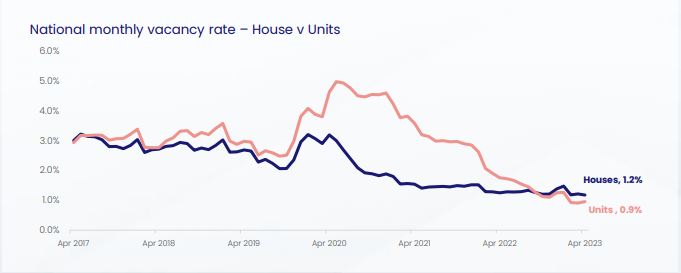This is compared with a national rental increase of 10.1% from April '22 to April '23.
This can partially be explained by the bounce back after rental deflation during the pandemic, as Australians return to densely populated areas now lockdowns and other restrictions are behind us.
However, with vacancy rates near record lows and a mismatch between supply and demand, the market looks likely to continue tightening.
After spiking in 2020, vacancy rates for both houses and units have been on a steep downward trajectory to currently sit at 1.2% and 0.9% respectively, far below the 3-5% average rate Core Logic say represents a balanced market.
Supply continues to be constricted, with the four week average for new capital city rental listings 20.9% below this time last year, and 39.8% less than the previous five year average.
Combined with a surge in overseas migration and international students, Australia simply doesn't have enough rental properties to go around.

Relief for renters on the way?
CoreLogic says that relief for renters is unlikely in the short to medium term, with no sign of the supply/demand discrepancy correcting itself.
There will likely be increased scrutiny on state governments, and the measures taken to protect renters.
From July this year, Queensland will only allow one rental increase per year, bringing it in line with NSW, Victoria, SA and Tasmania.
The move is designed to protect tenants from exorbitant rate jumps, but has drawn heavy criticism, from advocates for both tenants and landlords.
Some feel it is insufficient, while others, particularly real estate professionals, say that extra restrictions will deter people from investing in property, ultimately putting further restrictions on supply and exacerbating the problems.
“There’s already been an onslaught of rental legislative changes in our state and you begin to wonder how much more rental reform will Queensland property investors take," said Antonia Mercorella, the CEO of the Real Estate Institute of Queensland.
Alternative policy suggestions focus on the supply issues at source, particularly the building of new properties.
Supply chains were ravaged by Covid, driving up the cost of materials, while the construction industry also suffered from skilled labour shortages.
Consequently, the number of planned new residential properties is declining, a significant factor in housing supply problems.
Many are calling for substantial government investment to build new properties across Australia.
“The HIA has always agreed more needs to be done at the federal, state, and local level of government, to achieve a sustainable level of supply where both the cost of buying or renting a house is in the grasp of the average Australian,” said Jocelyn Martin, the deputy managing director of industry and policy at the Housing Industry Association.
In a 2017 report on Housing Affordability, Productivity Commission and former RBA governor Glenn Stevens also called for the approval process for new homes to be streamlined.
"What [the construction industry] need[s] is faster processes for converting zoning and development applications into construction and an ability to respond to those segments of the market that will accept smaller, lower cost dwellings," the report read.
What does May's cash rate increase mean?
While most coverage focuses on mortgage holders, yesterday's monetary policy decision is likely to bode ominously for renters as well.
Investment property owners typically pass on increases to their mortgage repayments to their tenants, but are also influenced by a multitude of other factors.
High interest rates also can dissuade buyers who would have bought a property to live in, keeping them in the pool of potential renters and keeping competition fierce.
Last week in a joint paper with the ABS, RBA economists revealed some insights into the state of the rental market.
"Over the past year, rents have increased for almost three-quarters of properties, up from around one-quarter every year pre-pandemic," the paper read.
"Since mid-2021, the majority of new tenants have been paying higher rent than was charged for the same property the year prior. This share increased to as high as 94% in February 2023, compared with 71% for properties with existing tenants."
Advertisement
Buying an investment property or looking to refinance? The table below features home loans with some of the lowest interest rates on the market for investors.
| Lender | Home Loan | Interest Rate | Comparison Rate* | Monthly Repayment | Repayment type | Rate Type | Offset | Redraw | Ongoing Fees | Upfront Fees | LVR | Lump Sum Repayment | Additional Repayments | Split Loan Option | Tags | Features | Link | Compare |
|---|---|---|---|---|---|---|---|---|---|---|---|---|---|---|---|---|---|---|
6.19% p.a. | 6.58% p.a. | $2,447 | Principal & Interest | Variable | $0 | $530 | 90% | Featured 90% LVR |
| |||||||||
6.29% p.a. | 6.20% p.a. | $2,473 | Principal & Interest | Variable | $0 | $0 | 80% | Featured Apply In Minutes |
| |||||||||
6.29% p.a. | 6.42% p.a. | $2,473 | Principal & Interest | Variable | $10 | $690 | 90% | |||||||||||
6.29% p.a. | 6.57% p.a. | $2,473 | Principal & Interest | Variable | $299 | $299 | 80% | |||||||||||
6.29% p.a. | 6.35% p.a. | $2,473 | Principal & Interest | Variable | $0 | $799 | 80% |
Picture by Brett Sayles on Unsplash

Ready, Set, Buy!
Learn everything you need to know about buying property – from choosing the right property and home loan, to the purchasing process, tips to save money and more!
With bonus Q&A sheet and Crossword!





